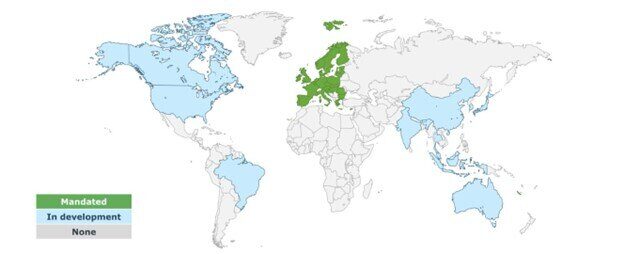3 min read
Emerging Trends in the Pulp, Paper, and Forestry Industry to Watch
 Matt Elhardt
:
Nov 5, 2024 12:00:00 AM
Matt Elhardt
:
Nov 5, 2024 12:00:00 AM

In an industry as dynamic as forest products, staying ahead of trends is essential for maintaining a competitive edge. The convergence of sustainability efforts, technological advancements, and market demands has created a landscape rich with opportunities and challenges.
As we approach the end of another year, ResourceWise feels it's important to share with professionals what future trends they can anticipate and prepare for. Whether you're looking to optimize operations or evaluate investment opportunities, these insights will serve as a valuable guide.
Biofuels on the Rise
As most companies have learned by now, sustainability is no longer optional; it's a necessity. With the global push towards greener energy solutions, biofuels are gaining traction.
Specifically, the demand for sustainable aviation fuel (SAF) is expected to see exponential growth. By 2025, global SAF demand is projected to reach 1.6 million tons, increasing to 20 million tons by 2030. Importantly, the increase in demand in 2025 is being driven by the first large-scale implementation of mandates.
Global SAF Mandates in 2025

Drivers of 2030 expected growth of projected SAF demand include:
- The EU's mandate for a 6% blend by 2030
- The UK's mandate for a 10% blend by 2030
- US Grand Challenge sets circa 10% blend target by 2030
- Multiple major US and European airlines' 10% blend intention by 2030. For example, Ryanair has committed to implementing a 12.5% discretionary blend by 2030.
- ICAO’s "Ambition" for 5% CO2 savings from international SAF blends by 2030
The rise in SAF demand presents notable opportunities for forest products professionals, particularly in the utilization of woody biomass, forestry residues, and other feedstocks. As the industry scales up SAF production, these raw materials, abundant in forests, will become increasingly valuable.
Another promising avenue is the use of crude tall oil, a byproduct of the pulp production process, to produce SAF. Currently, fewer than 200 mills extract crude tall oil, as reported by FisherSolve. This leaves substantial room for growth.
By investing in machinery to extract crude tall oil or transitioning facilities into biorefineries, businesses within the forestry sector can capitalize on this trend. The move would add an additional revenue stream and enhance their sustainability practices.
However, it's not without challenges. Markets are still developing, which means professionals must skillfully manage volatility, price fluctuations, and feedstock availability. Success in this market requires navigating a complex web of factors, but the long-term potential is undeniable.
ResourceWise's Prima CarbonZero platform is an invaluable tool for forest professionals aiming to navigate the expanding landscape of sustainable aviation fuel (SAF) demand. With comprehensive historical datasets encompassing biodiesel, renewable diesel, and SAF plants, Prima offers crucial insights into feedstock optimization and process technology that are fundamental for capitalizing on emerging opportunities.
By leveraging Prima's robust capabilities, professionals can map global pricing across best-in-class low-carbon fuel and feedstock prices. The data provides a strategic advantage in understanding the intricate balance between international supply and demand. This understanding is vital for effective ESG reporting and implementing impactful fuel decarbonization strategies, ensuring that investment decisions align with the carbon transition goals.
ResourceWise also offers other unique data sets and expertise that aid in strategic planning and decision-making. This includes:
- Detailed data sets describing every pulp mill in the world, including those producing CTO and those that could potentially produce it.
- Cash flow models that help you understand the benefits of producing CTO.
- FisherSolve benchmarking that can help you model crude tall oil yields and availability, as well as potential financial benefits.
European to U.S. South Wood Cost Gap
Wood costs have always been a critical factor in the forest products industry. Recently, a noteworthy trend has emerged—the growing cost gap between European and US South wood. According to ResourceWise data, what was once a $30 difference in softwood pulp log prices at the start of 2022 has expanded to a $75 gap. This widening discrepancy has implications for sourcing strategies and market competitiveness.

Cost dynamics can significantly impact profitability. Understanding regional cost drivers and adapting sourcing strategies accordingly will be crucial for maintaining a competitive edge in the global market.
WoodMarket Prices monitors and analyzes price and trade data in the timber, wood products, and pulp and paper sectors, offering invaluable insights for business strategy.
Its unique indices provide a comprehensive view of pricing data and market analytics from diverse regions around the world including North America, Europe, and South America. It also offers a global price index and a European price index.
The Sawlog Price Indices, providing information on buying and selling costs, are particularly beneficial. With sawlog costs constituting 65–70% of softwood lumber manufacturing, these indices can provide crucial data to help understand the competitiveness of regional sawmilling industries in the face of increasing cost gaps.
The Importance of Reliable Data
In a rapidly changing industry, access to reliable data is paramount. Making informed investment decisions, identifying emerging trends, and optimizing operations all hinge on accurate and timely information. With a focus on providing comprehensive data and analytics, ResourceWise equips industry professionals with the tools they need to make better business decisions.
ResourceWise's expertise in forest products, low-carbon fuels, biomaterials, and chemicals sets it apart as a trusted partner in navigating complex commodity markets. By leveraging their insights, companies can confidently chart a course toward a more sustainable and profitable future.
For a deeper understanding of how ResourceWise's data platforms and expert consulting can help you navigate the complexities of the forest products industry, visit our forest products page today.






